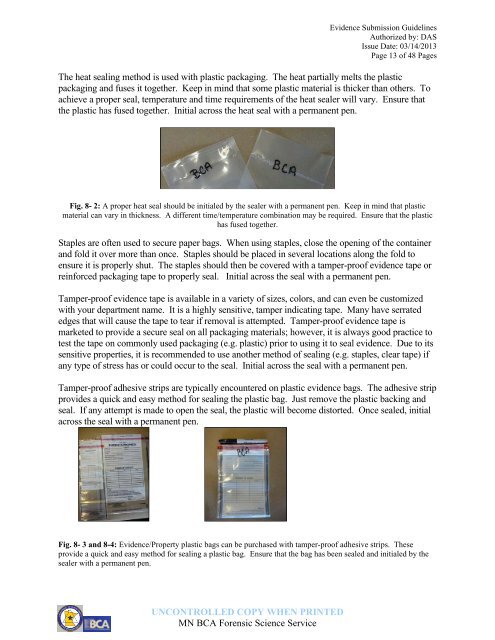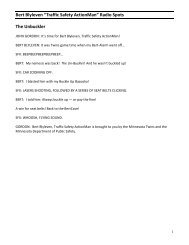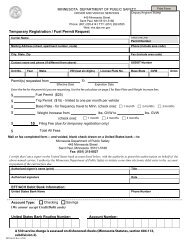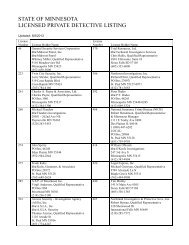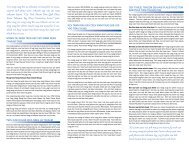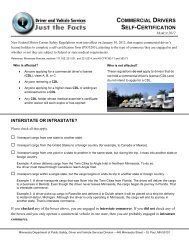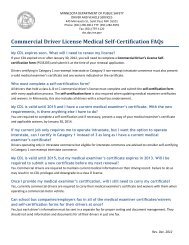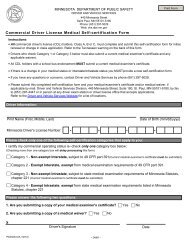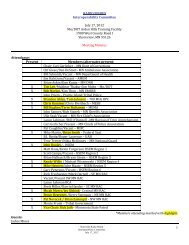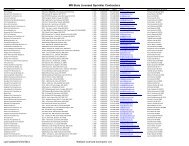Evidence Submission Guidelines - Minnesota Department of Public ...
Evidence Submission Guidelines - Minnesota Department of Public ...
Evidence Submission Guidelines - Minnesota Department of Public ...
Create successful ePaper yourself
Turn your PDF publications into a flip-book with our unique Google optimized e-Paper software.
UNCONTROLLED COPY WHEN PRINTED<br />
MN BCA Forensic Science Service<br />
<strong>Evidence</strong> <strong>Submission</strong> <strong>Guidelines</strong><br />
Authorized by: DAS<br />
Issue Date: 03/14/2013<br />
Page 13 <strong>of</strong> 48 Pages<br />
The heat sealing method is used with plastic packaging. The heat partially melts the plastic<br />
packaging and fuses it together. Keep in mind that some plastic material is thicker than others. To<br />
achieve a proper seal, temperature and time requirements <strong>of</strong> the heat sealer will vary. Ensure that<br />
the plastic has fused together. Initial across the heat seal with a permanent pen.<br />
Fig. 8- 2: A proper heat seal should be initialed by the sealer with a permanent pen. Keep in mind that plastic<br />
material can vary in thickness. A different time/temperature combination may be required. Ensure that the plastic<br />
has fused together.<br />
Staples are <strong>of</strong>ten used to secure paper bags. When using staples, close the opening <strong>of</strong> the container<br />
and fold it over more than once. Staples should be placed in several locations along the fold to<br />
ensure it is properly shut. The staples should then be covered with a tamper-pro<strong>of</strong> evidence tape or<br />
reinforced packaging tape to properly seal. Initial across the seal with a permanent pen.<br />
Tamper-pro<strong>of</strong> evidence tape is available in a variety <strong>of</strong> sizes, colors, and can even be customized<br />
with your department name. It is a highly sensitive, tamper indicating tape. Many have serrated<br />
edges that will cause the tape to tear if removal is attempted. Tamper-pro<strong>of</strong> evidence tape is<br />
marketed to provide a secure seal on all packaging materials; however, it is always good practice to<br />
test the tape on commonly used packaging (e.g. plastic) prior to using it to seal evidence. Due to its<br />
sensitive properties, it is recommended to use another method <strong>of</strong> sealing (e.g. staples, clear tape) if<br />
any type <strong>of</strong> stress has or could occur to the seal. Initial across the seal with a permanent pen.<br />
Tamper-pro<strong>of</strong> adhesive strips are typically encountered on plastic evidence bags. The adhesive strip<br />
provides a quick and easy method for sealing the plastic bag. Just remove the plastic backing and<br />
seal. If any attempt is made to open the seal, the plastic will become distorted. Once sealed, initial<br />
across the seal with a permanent pen.<br />
Fig. 8- 3 and 8-4: <strong>Evidence</strong>/Property plastic bags can be purchased with tamper-pro<strong>of</strong> adhesive strips. These<br />
provide a quick and easy method for sealing a plastic bag. Ensure that the bag has been sealed and initialed by the<br />
sealer with a permanent pen.


